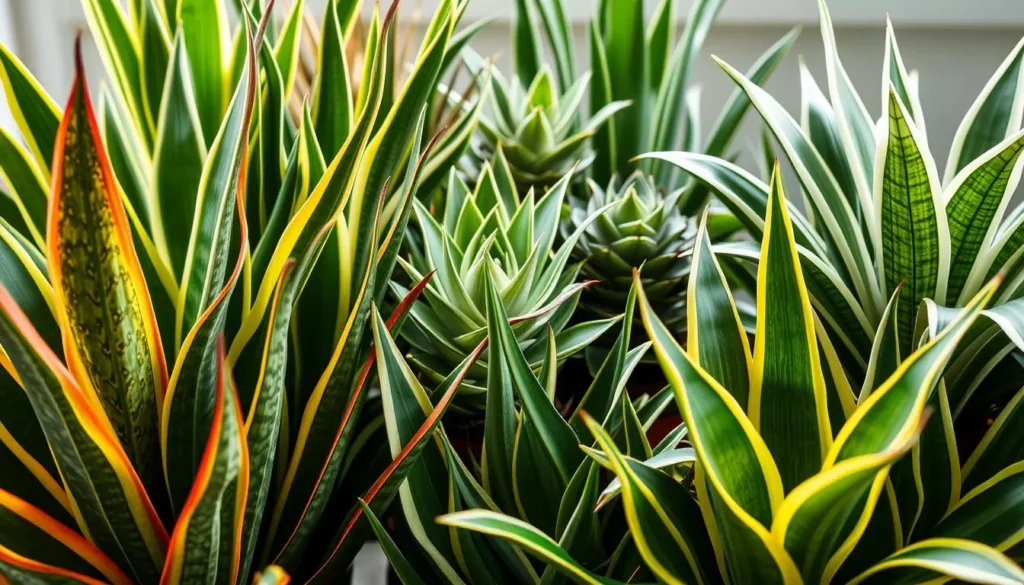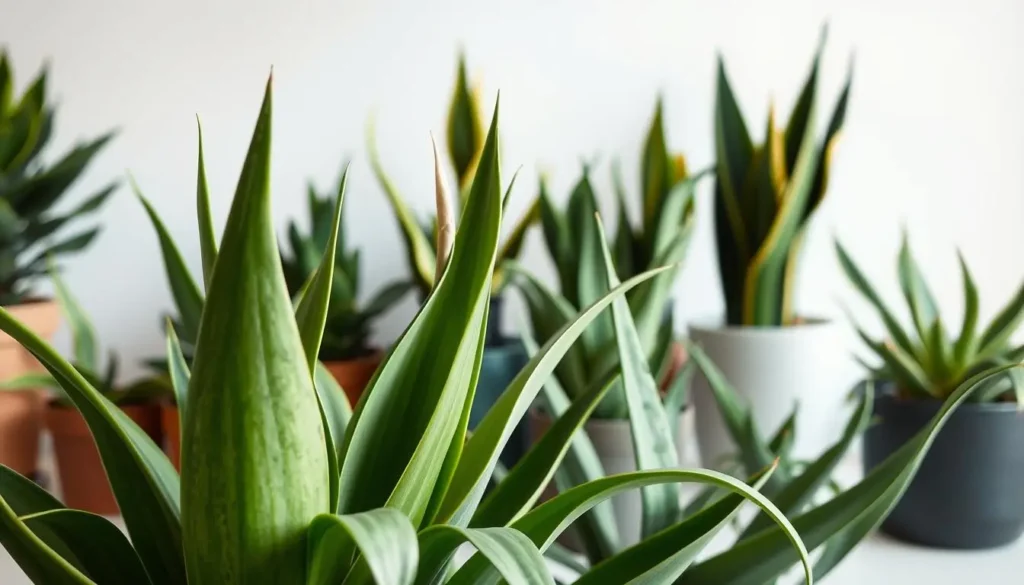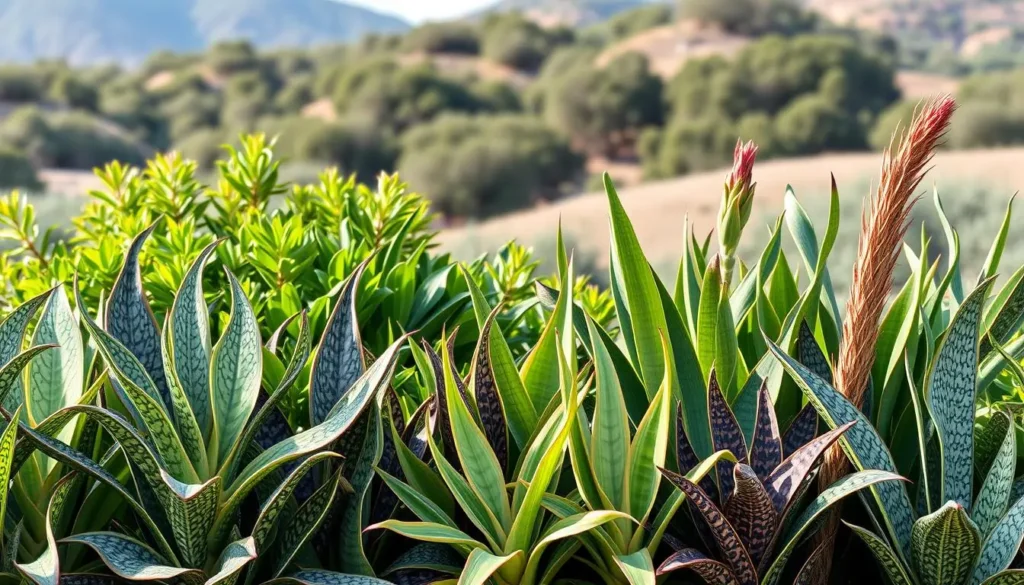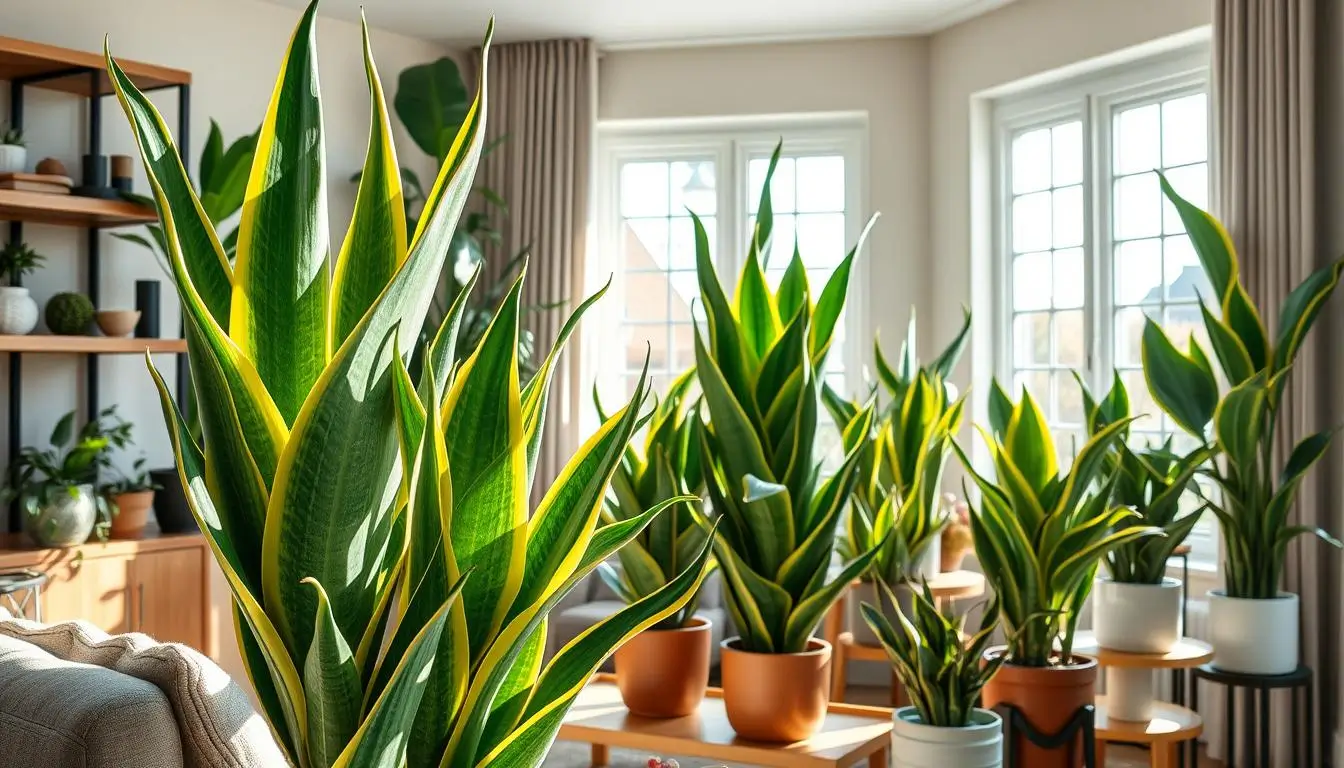Snake Plant Varieties: Thrilling Types You Need to Know.
Ever looked at a wilting houseplant and wished it could thrive on its own? Snake plants are the answer. They’re not just plants; they’re botanical superheroes. With their sleek leaves and twisted forms, snake plant varieties bring a lot of variety to your home.
Imagine a corner of your home with a bold Sansevieria Laurentii adding modern flair. Or a compact Samurai variety that fits perfectly on your desk. These plants don’t just survive; they turn empty spaces into vibrant, low-maintenance spots.
Once just office plants, different types of snake plants now decorate stylish homes and minimalist spaces. Their popularity isn’t a coincidence. They thrive in dim corners, tolerate forgetful watering, and adapt to busy lives. Whether you’re new to plants or collecting rare ones, there’s a variety for you.
Key Takeaways
- Over 70 recognized snake plant varieties offer unique shapes and colors.
- Most tolerate low light and irregular watering, making them ideal for U.S. households.
- From compact desktop plants to tall floor specimens, sizes suit any living area.
- They’re proven air purifiers, removing toxins like formaldehyde and benzene.
- Rare types like Cylindrica or Whale Fin add exotic flair to modern homes.
Understanding the Popularity of Snake Plants in American Homes
Snake plants are now a common sight in American homes. They mix practicality with style. Their popularity comes from being tough and easy to care for in indoor snake plant varieties of homes.
These plants do well in low light, need little water, and can handle neglect. This makes them ideal for people with busy lives.

- Low maintenance: Survive weeks without water or direct sunlight.
- Air-purifying: Improve indoor air quality by removing toxins.
- Versatile design: Fit modern, minimalist, or bohemian decor effortlessly.
Snake plants have made a comeback, appearing in magazines and on social media. Their unique shapes bring drama to any space, whether it’s a small apartment or a large home. Varieties like Laurentii or cylindrical ones add interest without needing constant care.
| Feature | Why It Matters |
|---|---|
| Low light tolerance | Perfect for rooms with limited natural light. |
| Design flexibility | Pair with modern ceramics or rustic pots for any aesthetic. |
| Health benefits | Purify air while requiring minimal care. |
In cities like New York and suburban areas, indoor snake plant varieties are a hit. They offer both beauty and convenience, making them a favorite among Americans.
Most Common Snake Plant Varieties for Beginners
Starting with snake plant varieties is exciting. Choosing the right one is key to success. These three are perfect for beginners because they can handle neglect. They offer beauty and easy care.

Sansevieria Trifasciata (Mother-in-Law’s Tongue)
- Distinct upright leaves with yellow edges
- Grows 2–4 feet tall, perfect for desks or corners
- Tolerates infrequent watering and low light
Sansevieria Zeylanica (Ceylon Bowstring Hemp)
- Gray-green bands on slender leaves
- Compact size (1–2 feet), ideal for small spaces
- Handles indirect light and sporadic care routines
Sansevieria Laurentii (Variegated Snake Plant)
- Yellow margins contrast with dark green leaves
- Reaches 3–5 feet, adding bold style to rooms
- Forgiving of missed waterings and dim rooms
| Variety | Key Traits | Light Needs | Size |
|---|---|---|---|
| Mother-in-Law’s Tongue | Yellow-edged leaves | Low to bright | 2–4’ |
| Ceylon Bowstring Hemp | Gray-green bands | Medium indirect | 1–2’ |
| Variegated Snake Plant | Bold yellow margins | Low to moderate | 3–5’ |
These best snake plant varieties are great for beginners. They are tough and don’t get sick easily. Choose one that fits your space and style. They’re easy to care for, making them a great choice for new plant owners.
Exploring Rare and Unique Snake Plant Varieties
Step into the world of unique snake plant varieties that turn ordinary spaces into botanical showcases. These top snake plant species are cherished for their bold forms and scarcity. They make great additions for serious collectors.

These plants aren’t just plants—they’re conversation starters that redefine indoor aesthetics.
Sansevieria Cylindrica (Cylindrical Snake Plant)
Its round, stiff leaves grow in upright clusters. They are often braided or twisted into decorative shapes. This variety thrives in bright indirect light, adding a sculptural touch to modern interiors.
Sansevieria Masoniana (Whale Fin)
The Whale Fin’s single paddle-shaped leaf can stretch over two feet long. It resembles a whale’s fin. A social media darling, it’s a dramatic focal point for shelves or floor displays.
Sansevieria Ehrenbergii (Blue Sansevieria)
Velvety blue-gray leaves fan out from the base, creating a striking contrast against green plants. Its slow growth makes it perfect for those who prefer low-maintenance elegance.
Sansevieria Samurai (Samurai Dwarf)
Compact and sturdy, this variety stays under 12 inches tall. Its short, spiky leaves with yellow stripes pack a punch in small spaces like desks or entryways.
- Cylindrica: $40–$80, available at specialty garden centers.
- Whale Fin: Popular online, prices up to $150 for mature specimens.
- Blue Sansevieria: Prized for rarity, often sold in clusters.
- Samurai Dwarf: Compact size keeps costs lower at $25–$40.
These unique snake plant varieties reward patience and curiosity. Their availability varies, but their visual impact ensures they’re worth the search. Whether for style or scarcity, they’re top snake plant species for serious growers.
Best Snake Plant Varieties for Small Spaces and Apartments
Make the most of your space with the best snake plant varieties for small areas. These plants are perfect for apartments, adding greenery without taking up too much room. They are under 12 inches tall and do well indoors.
- Sansevieria ‘Futura Superba’: Narrow, upright leaves form a compact rosette, fitting perfectly on desks or bookshelves.
- Sansevieria ‘Bird’s Nest’: Curled, spiral leaves cluster close to the soil, ideal for shallow pots and windowsills.
- Sansevieria ‘Hahnii’:; Creeping rhizomes spread horizontally, creating a trailing effect in hanging planters or narrow shelves.
| Variety | Max Height | Space-Saving Tips |
|---|---|---|
| ‘Futura Superba’ | 8-10″ | Rotate weekly for even growth in low-light corners |
| ‘Bird’s Nest’ | 6″ | Trim offsets to control spread in tight spaces |
| ‘Hahnii’ | 4-6″ | Repot every 2 years to prevent root congestion |
Match these snake plant varieties with shallow pots or vertical planters for a modern look. They grow slowly, which means less care. They’re great for renters or city folks.
Use ‘Hahnii’ in bathrooms for humidity and ‘Futura Superba’ in entryways to clean the air. Pick varieties that fit your lifestyle—no big leaves to clutter your space.
Low Light Snake Plant Varieties That Thrive in Shade
Dark corners and north-facing rooms aren’t off-limits for greenery. Low light snake plant varieties like Sansevieria trifasciata ‘Black Gold’ and ‘Black Coral’ do well in little sunlight. Their dark leaves soak up what little light they get, making them great for indoor snake plant varieties in dim spots.
- Sansevieria ‘Black Gold’: Its dark green stripes stay bright with minimal light. Keep it away from direct sun to avoid burning.
- Sansevieria ‘Black Coral’: Its deep green leaves with yellow edges do well in offices or hallways. Dust them weekly to help them photosynthesize.
These plants have special cells for photosynthesis, needing only 10-20% of the light that sun-loving plants need. Water them only when the soil is completely dry—too much water can harm them more than too little light. Use a light meter to check if a spot has less than 100 foot-candles of light.
Myth: All snake plants grow equally in any light. Truth: Low light snake plant varieties grow slower but stay healthy. Yellow leaves mean you’re watering too much, not that they need more light. Check the soil before watering—dry soil is ready for water.
The Essential Guide to Snake Plant Varieties Care
Snake plant care tips vary by type. Learn how to adjust watering, soil, and light for each variety to keep them thriving.
Watering Requirements Across Varieties
Thick-leaved plants like Sansevieria Cylindrica need less water. Thin-leaved ones, like Sansevieria Trifasciata, might need a bit more. Here’s what to do:
- Water only when soil is dry 2 inches deep.
- Reduce watering by half during winter months.
- Avoid overwatering—yellowing leaves signal root rot risks.
Soil and Potting Preferences
Each variety prefers a specific soil mix and pot. Choose based on your plant’s root structure:
| Plant Type | Soil Mix | Potting Tips |
|---|---|---|
| Sansevieria Laurentii | Equal parts potting soil and perlite | Clay pots with drainage holes |
| Sansevieria Masoniana | Coarse sand blended with cactus mix | Wide, shallow pots for spreading roots |
| Sansevieria Ehrenbergii | Standard potting soil with added gravel | Small pots to limit overgrowth |
Light Requirements and Adaptation
Variegated plants like Sansevieria Laurentii need bright light to keep their patterns. Solid green types, such as Sansevieria Trifasciata, can handle lower light but grow slower in dim conditions.
“Light adaptation is key to preserving variegation in different types of snake plants.” – The American Horticultural Society
Adjust care based on your plant’s leaf type and environment. Regular checks ensure each variety stays healthy and vibrant.
How to Propagate Different Types of Snake Plants
Expanding your snake plant collection is easy with these proven methods. Snake plant care tips for propagation vary depending on the variety, but all thrive with patience and the right approach. Let’s explore techniques tailored to different types of snake plants.
Leaf Cutting Propagation Methods
Select a healthy leaf from varieties like Laurentii or Trifasciata. Cut a 4–6 inch segment at a diagonal. Let the cut end callus for 24 hours. Plant in well-draining soil or submerge in water until roots appear.
Note: Variegated varieties may revert to green when propagated this way. For best results, use rooting hormone powder.
Division Techniques for Mature Plants
When repotting, gently separate mature clumps into sections with their own roots. Varieties like Cylindrica have tuberous roots, while others like Masoniana have fibrous systems. Ensure each division has at least two healthy rhizomes.
Water sparingly after division to avoid rot.
Water Propagation Tips and Tricks
Submerge the base of a leaf node in clean water. Change water weekly to prevent mold. Laurentii and Cylindrica varieties root fastest in this method.
Once roots form, transplant to soil within two weeks. Avoid direct sunlight during the water phase.
Pro tip: Propagate during spring for faster growth. Check roots weekly and adjust methods based on your plant’s response.
Decorating Your Home with Various Snake Plant Types
Snake plants are more than just plants—they’re design tools. Their bold shapes and easy care make them perfect for any room. They fit right in, whether your style is modern or farmhouse.
- Pair Sansevieria Trifasciata’s upright leaves with mid-century modern furniture for clean lines.
- Group cylindrical varieties like Sansevieria Cylindrica in terracotta pots to create a sculptural focal point.
- Use compact varieties such as Samurai on shelves to add texture without overwhelming small spaces.
Containers are important too. Choose white pots for minimalist decor or colorful ones for variegated plants like Laurentii. Tall plants like Whale Fin look great in corners. Interior designers often group 3-5 plants for a lively look.
Use Sansevieria Zeylanica’s narrow leaves to frame a fireplace or desk. These plants are tough, so you can try new things without worry. They add life to any room, needing little care.
Health Benefits of Growing Popular Snake Plant Types
Popular snake plants do more than look good. They make your home healthier in many ways. They clean the air and help you relax, making your space better.
Air Purification Properties
NASA found that Sansevieria trifasciata and others clean the air. They remove toxins like formaldehyde and benzene. They also make oxygen at night, perfect for bedrooms.
Studies say having two to four medium plants in a room can really improve air quality.
Stress Reduction and Wellness Effects
Plants like Sansevieria laurentii help lower stress hormones. They are easy to care for, which reduces stress. Research shows they can also help you sleep better and feel less anxious.
Feng Shui Benefits of Snake Plants
In Feng Shui, snake plants stand for strength and protection. Put them in corners to block bad energy. Or near doors to protect your space.
Tall plants like Cylindrica add to the earth element, balancing your home’s energy.
Troubleshooting Common Issues with Indoor Snake Plant Varieties
Even the toughest snake plant varieties can run into problems. If your tall Sansevieria Cylindrica leaves droop, it’s a sign of too much water. Brown edges on leaves? That might mean your variegated plants like Laurentii need more humidity. Here are some fixes for common issues:
- Leaf Flopping: Trim off too much foliage and repot in soil that drains well.
- Brown Tips: Mist your plants every week or use a pebble tray to increase humidity.
- Yellow Leaves: Water them less often and check for root rot.
- Pest Infestations: Clean leaves with soapy water to get rid of mealybugs.
| Issue | Cause | Solution |
|---|---|---|
| Faded Variegation | Low light | Move to bright, indirect light |
| Soft Stems | Overwatering | Let soil dry completely |
| Leaf Curl | Cold drafts | Relocate away from windows in winter |
Always check the roots before repotting to catch root rot early. Keep an eye on your snake plant care tips for each variety’s special needs. For instance, Sansevieria Masoniana likes more humidity than the usual types.
Adjust your care based on the specific snake plant varieties you have. Regular checks can stop small problems from getting bigger. A bit of care can make all varieties flourish.
Seasonal Care Tips for Maintaining Vibrant Snake Plant Varieties
Seasonal changes mean we need to adjust our snake plant care tips to keep them healthy all year. Follow these steps to help your plants grow and rest properly, for the top snake plant species.
Spring and Summer Growth Management
In warmer months, we need to give our plants more care to help them grow. Water them when the soil is dry, but don’t let it get too wet. Fertilize every six weeks with a special cactus mix. If leaves turn yellow, it’s a sign you’re watering too much.
Species like Sansevieria Trifasciata do well in brighter, indirect light during this time.
- Increase humidity with pebble trays if indoor air dries out.
- Trim damaged leaves to redirect energy to new growth.
Fall and Winter Dormancy Care
“Cold drafts and overwatering are top threats in winter,” warns horticulturist Maria Green. “Let soil dry fully before watering, and keep temps above 50°F (10°C).
Stop fertilizing altogether. Water slower growers like Sansevieria Cylindrica only once a month. Use humidifiers only if the air gets too dry.
Repotting Schedule by Variety
Repotting is key for root health. Fast growers like Sansevieria Trifasciata need a new pot every 2-3 years. Slower growers, like Sansevieria Masoniana (Whale Fin), can go 3-4 years.
Always use pots with holes to prevent root rot.
Watch for when the roots get too crowded. This means it’s time for a bigger pot, no matter the season.
Conclusion: Choosing the Perfect Snake Plant Variety for Your Lifestyle
Choosing the right snake plant varieties depends on your lifestyle. Busy professionals and design lovers can find the best snake plant varieties that fit their needs. First, think about your living space.
Small apartments are perfect for plants like Sansevieria Laurentii or Samurai Dwarf. Larger spaces can show off plants like Cylindrica or Whale Fin. If you’re new to plants, start with easy-care options like Mother-in-Law’s Tongue. It can handle neglect and low light well.
Consider your daily routine, too. If you have pets, choose plants with softer leaves, like Ehrenbergii, to avoid injuries. Design enthusiasts can pick plants for their bold patterns or unique shapes to enhance decor.
Remember, most snake plant varieties need infrequent watering and well-draining soil. Starting with one plant can lead to collecting more. Each type offers unique benefits, from purifying the air to reducing stress.
Look for plants like Laurentii for simplicity or Zeylanica for texture. This ensures your choice matches your space and habits. With so many snake plant varieties, you’ll find the perfect one for every corner of your life.
FAQ
What are the best snake plant varieties for beginners?
For beginners, the top snake plant varieties are Sansevieria Trifasciata (Mother-in-Law’s Tongue), Sansevieria Zeylanica (Ceylon Bowstring Hemp), and Sansevieria Laurentii (Variegated Snake Plant). These are easy to care for and tough, perfect for new plant lovers.
Which snake plant varieties are suitable for low light conditions?
Sansevieria trifasciata ‘Black Gold’ and ‘Black Coral’ are great for low light. They do well in shaded spots and can handle less light while staying healthy and looking good.
How do I care for different types of snake plants?
Snake plant care depends on the type. They like well-drained soil, moderate watering, and indirect light. Thicker-leaved plants like Sansevieria Masoniana need less water, while thinner-leaved ones might need a bit more.
Can you provide some unique snake plant varieties?
Yes! Unique varieties include Sansevieria Cylindrica (Cylindrical Snake Plant), Sansevieria Masoniana (Whale Fin), and Sansevieria Ehrenbergii (Blue Sansevieria). They have unique shapes and colors, making them great for adding style to your home.
What are the top snake plant species for small spaces?
For small spaces, consider Sansevieria ‘Futura Superba’ and ‘Hahnii.’ They stay under 12 inches tall. These plants are perfect for small areas, adding style and improving air quality without taking up too much space.
How do I propagate different types of snake plants?
Propagation methods vary. Leaf cutting works well for many, including variegated ones. Division is good for mature plants. Water propagation can also work for some, allowing roots to grow before moving to soil.
Why are snake plants popular in American homes?
Snake plants are loved in American homes for their easy care and air-purifying qualities. They fit well in many home styles, appealing to those who want beauty and health benefits without much effort.
What are some air purification benefits of snake plants?
Snake plants purify the air by removing toxins like formaldehyde and benzene. The NASA Clean Air Study found them effective in improving indoor air quality. They’re a great addition to any home.

